Design and Construction of Buildings in Nairobi, Kenya: Climate Change
VerifiedAdded on 2023/02/01
|10
|2069
|74
Report
AI Summary
This report provides an in-depth analysis of sustainable building design in Nairobi, Kenya, addressing the challenges of climate change adaptation. It examines key factors such as transportation, solar access, heating and cooling strategies, material efficiency, and the impact of rainfall, strong winds, and flooding on building design. The report emphasizes the importance of considering social, economic, and environmental dimensions to create resilient and sustainable buildings. It explores methodologies for design and construction, offering practical solutions for mitigating climate-related risks, including flood-proofing, structural reinforcement against strong winds, and the use of water-resistant materials. The study also discusses the significance of site selection, energy efficiency, and the integration of sustainable practices to meet the growing housing needs of Nairobi's population while minimizing environmental impact. The report concludes by highlighting the critical role of effective building design and urban planning in fostering a sustainable built environment for the future.
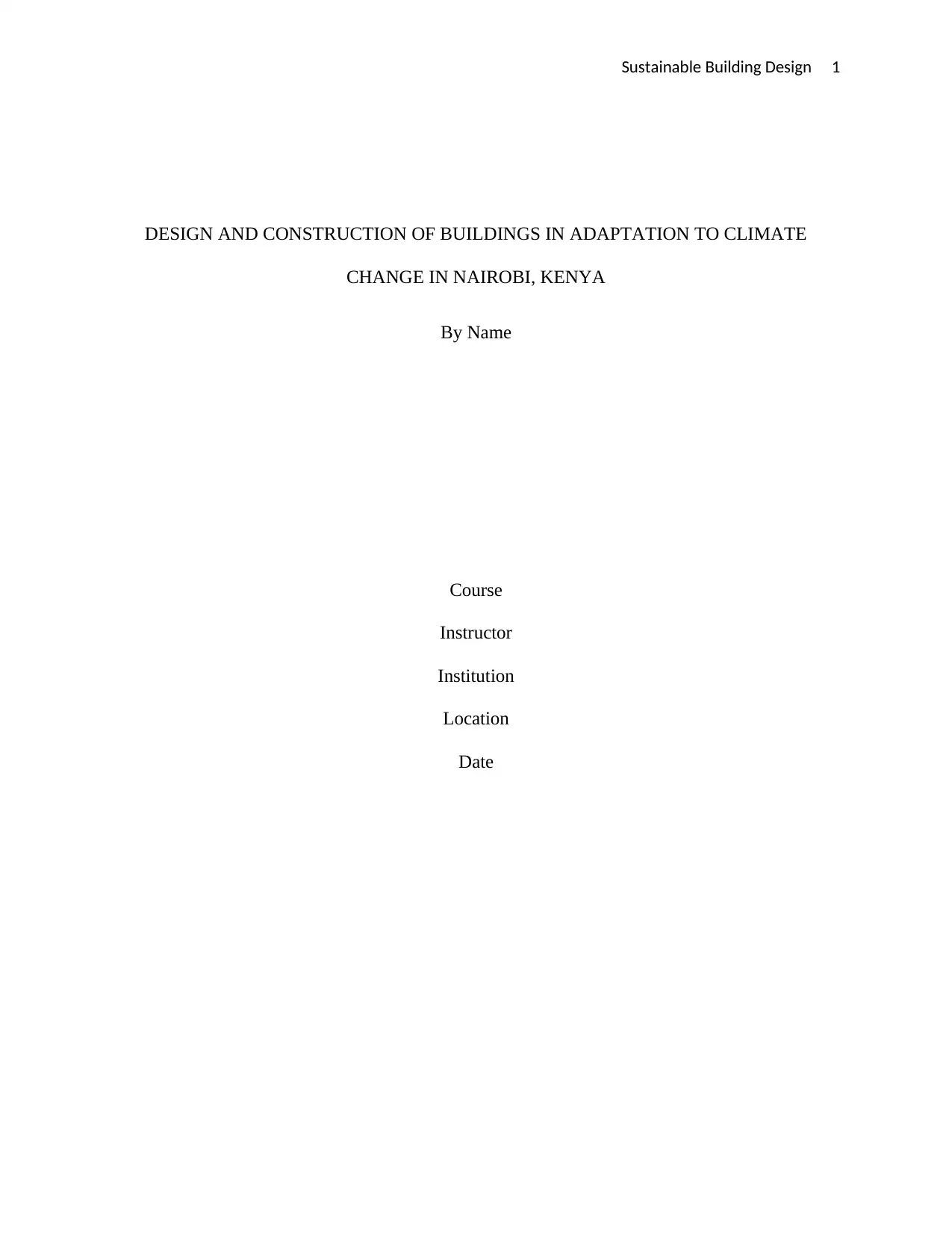
Sustainable Building Design 1
DESIGN AND CONSTRUCTION OF BUILDINGS IN ADAPTATION TO CLIMATE
CHANGE IN NAIROBI, KENYA
By Name
Course
Instructor
Institution
Location
Date
DESIGN AND CONSTRUCTION OF BUILDINGS IN ADAPTATION TO CLIMATE
CHANGE IN NAIROBI, KENYA
By Name
Course
Instructor
Institution
Location
Date
Paraphrase This Document
Need a fresh take? Get an instant paraphrase of this document with our AI Paraphraser
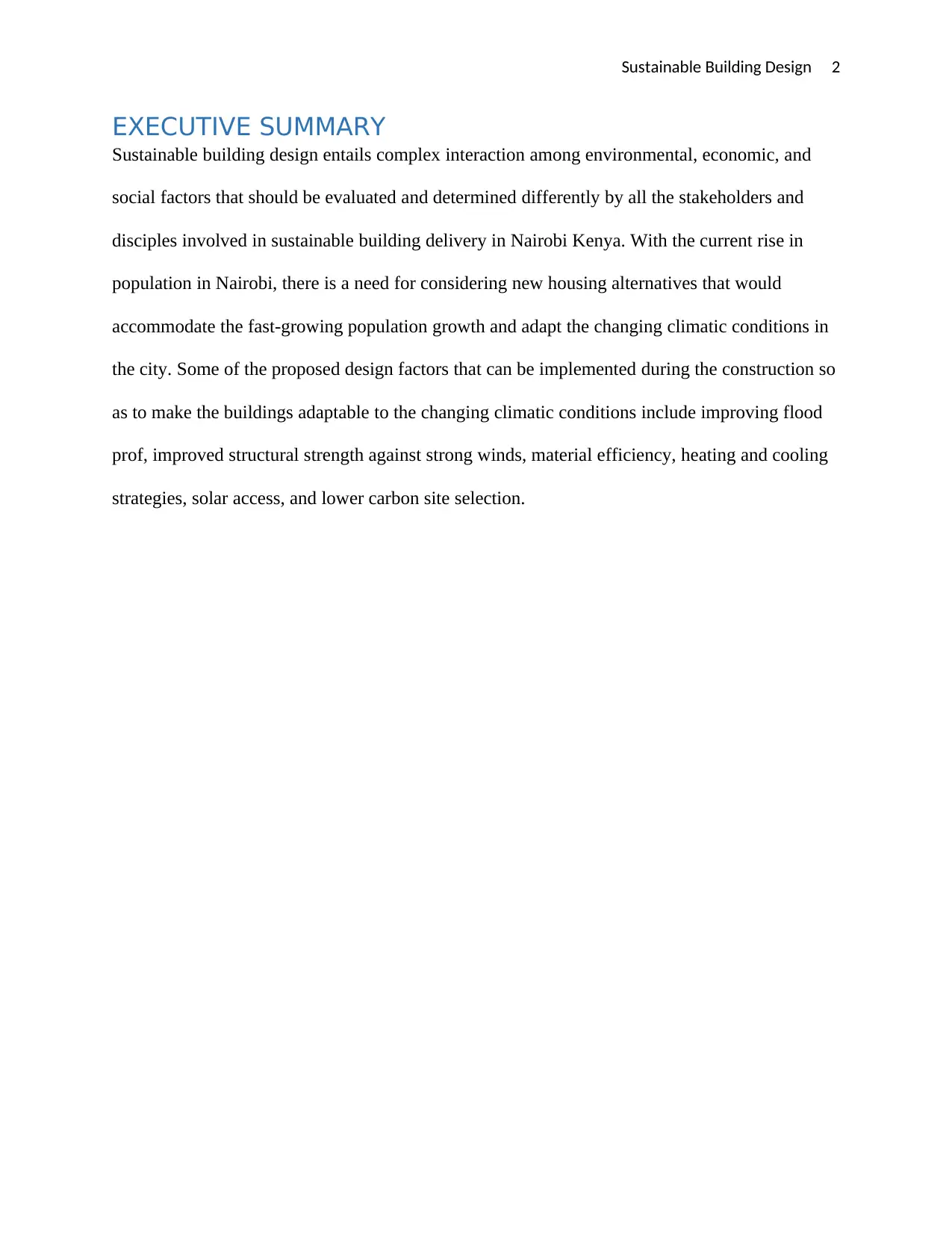
Sustainable Building Design 2
EXECUTIVE SUMMARY
Sustainable building design entails complex interaction among environmental, economic, and
social factors that should be evaluated and determined differently by all the stakeholders and
disciples involved in sustainable building delivery in Nairobi Kenya. With the current rise in
population in Nairobi, there is a need for considering new housing alternatives that would
accommodate the fast-growing population growth and adapt the changing climatic conditions in
the city. Some of the proposed design factors that can be implemented during the construction so
as to make the buildings adaptable to the changing climatic conditions include improving flood
prof, improved structural strength against strong winds, material efficiency, heating and cooling
strategies, solar access, and lower carbon site selection.
EXECUTIVE SUMMARY
Sustainable building design entails complex interaction among environmental, economic, and
social factors that should be evaluated and determined differently by all the stakeholders and
disciples involved in sustainable building delivery in Nairobi Kenya. With the current rise in
population in Nairobi, there is a need for considering new housing alternatives that would
accommodate the fast-growing population growth and adapt the changing climatic conditions in
the city. Some of the proposed design factors that can be implemented during the construction so
as to make the buildings adaptable to the changing climatic conditions include improving flood
prof, improved structural strength against strong winds, material efficiency, heating and cooling
strategies, solar access, and lower carbon site selection.
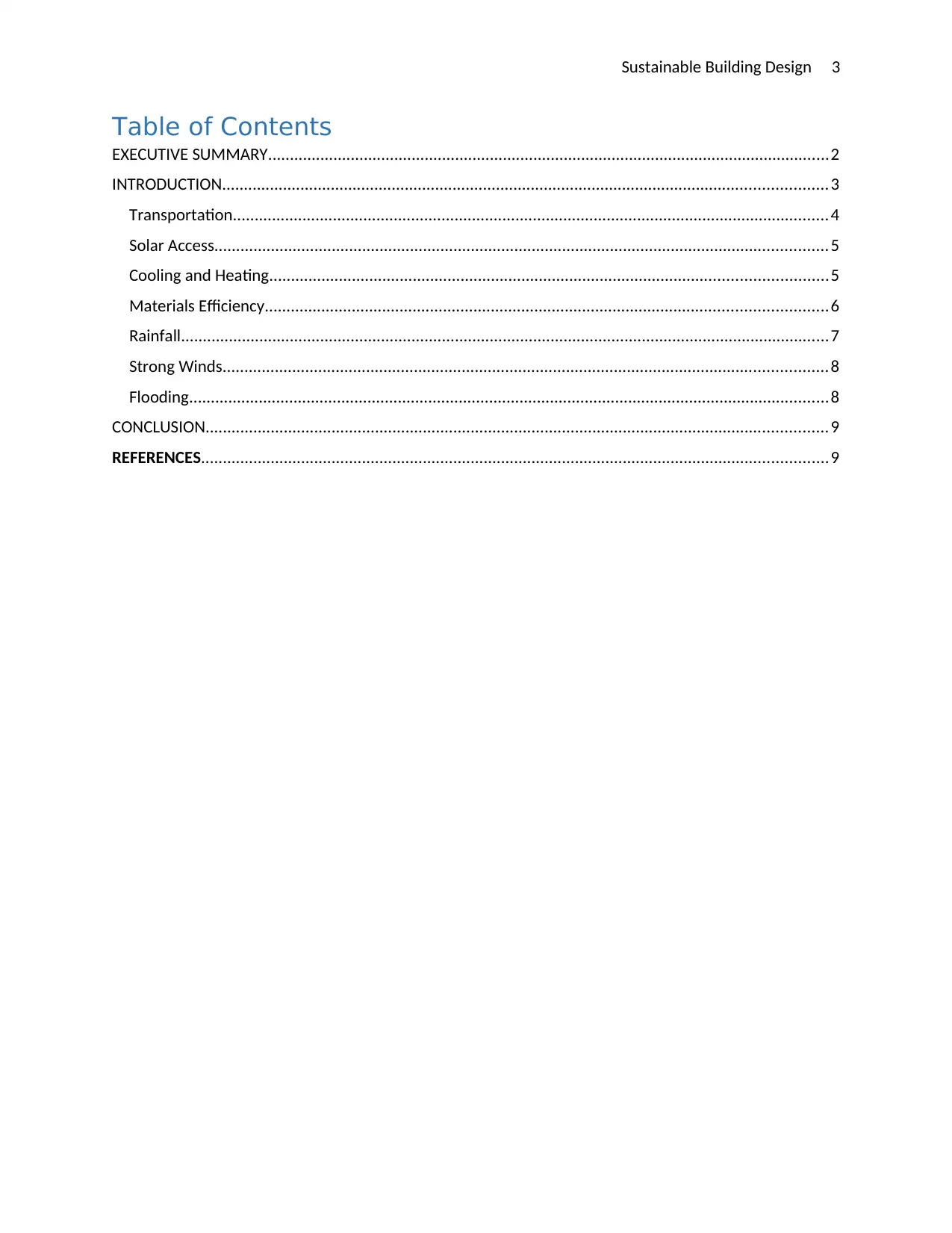
Sustainable Building Design 3
Table of Contents
EXECUTIVE SUMMARY.................................................................................................................................2
INTRODUCTION...........................................................................................................................................3
Transportation.........................................................................................................................................4
Solar Access.............................................................................................................................................5
Cooling and Heating................................................................................................................................5
Materials Efficiency.................................................................................................................................6
Rainfall.....................................................................................................................................................7
Strong Winds...........................................................................................................................................8
Flooding...................................................................................................................................................8
CONCLUSION...............................................................................................................................................9
REFERENCES................................................................................................................................................9
Table of Contents
EXECUTIVE SUMMARY.................................................................................................................................2
INTRODUCTION...........................................................................................................................................3
Transportation.........................................................................................................................................4
Solar Access.............................................................................................................................................5
Cooling and Heating................................................................................................................................5
Materials Efficiency.................................................................................................................................6
Rainfall.....................................................................................................................................................7
Strong Winds...........................................................................................................................................8
Flooding...................................................................................................................................................8
CONCLUSION...............................................................................................................................................9
REFERENCES................................................................................................................................................9
⊘ This is a preview!⊘
Do you want full access?
Subscribe today to unlock all pages.

Trusted by 1+ million students worldwide
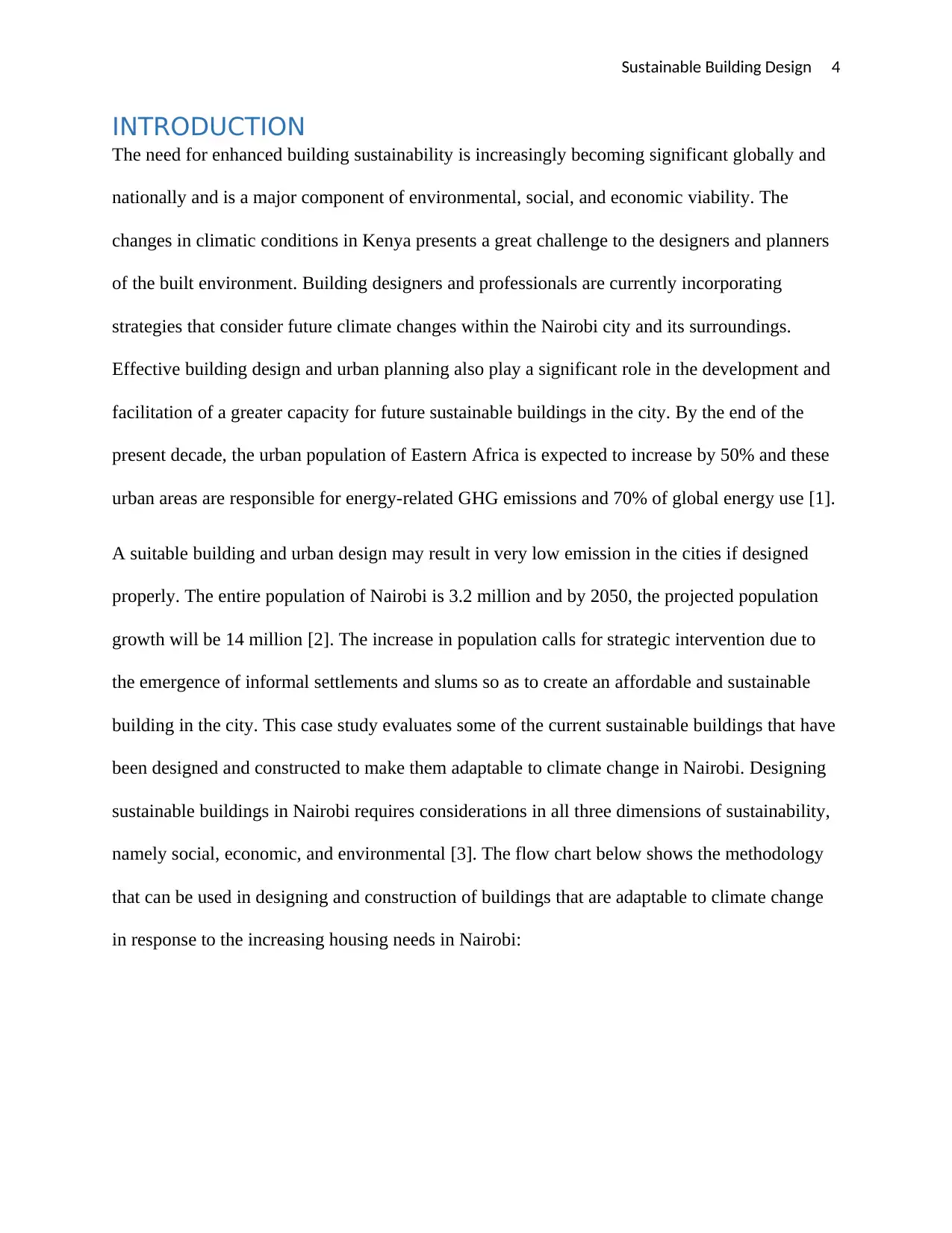
Sustainable Building Design 4
INTRODUCTION
The need for enhanced building sustainability is increasingly becoming significant globally and
nationally and is a major component of environmental, social, and economic viability. The
changes in climatic conditions in Kenya presents a great challenge to the designers and planners
of the built environment. Building designers and professionals are currently incorporating
strategies that consider future climate changes within the Nairobi city and its surroundings.
Effective building design and urban planning also play a significant role in the development and
facilitation of a greater capacity for future sustainable buildings in the city. By the end of the
present decade, the urban population of Eastern Africa is expected to increase by 50% and these
urban areas are responsible for energy-related GHG emissions and 70% of global energy use [1].
A suitable building and urban design may result in very low emission in the cities if designed
properly. The entire population of Nairobi is 3.2 million and by 2050, the projected population
growth will be 14 million [2]. The increase in population calls for strategic intervention due to
the emergence of informal settlements and slums so as to create an affordable and sustainable
building in the city. This case study evaluates some of the current sustainable buildings that have
been designed and constructed to make them adaptable to climate change in Nairobi. Designing
sustainable buildings in Nairobi requires considerations in all three dimensions of sustainability,
namely social, economic, and environmental [3]. The flow chart below shows the methodology
that can be used in designing and construction of buildings that are adaptable to climate change
in response to the increasing housing needs in Nairobi:
INTRODUCTION
The need for enhanced building sustainability is increasingly becoming significant globally and
nationally and is a major component of environmental, social, and economic viability. The
changes in climatic conditions in Kenya presents a great challenge to the designers and planners
of the built environment. Building designers and professionals are currently incorporating
strategies that consider future climate changes within the Nairobi city and its surroundings.
Effective building design and urban planning also play a significant role in the development and
facilitation of a greater capacity for future sustainable buildings in the city. By the end of the
present decade, the urban population of Eastern Africa is expected to increase by 50% and these
urban areas are responsible for energy-related GHG emissions and 70% of global energy use [1].
A suitable building and urban design may result in very low emission in the cities if designed
properly. The entire population of Nairobi is 3.2 million and by 2050, the projected population
growth will be 14 million [2]. The increase in population calls for strategic intervention due to
the emergence of informal settlements and slums so as to create an affordable and sustainable
building in the city. This case study evaluates some of the current sustainable buildings that have
been designed and constructed to make them adaptable to climate change in Nairobi. Designing
sustainable buildings in Nairobi requires considerations in all three dimensions of sustainability,
namely social, economic, and environmental [3]. The flow chart below shows the methodology
that can be used in designing and construction of buildings that are adaptable to climate change
in response to the increasing housing needs in Nairobi:
Paraphrase This Document
Need a fresh take? Get an instant paraphrase of this document with our AI Paraphraser
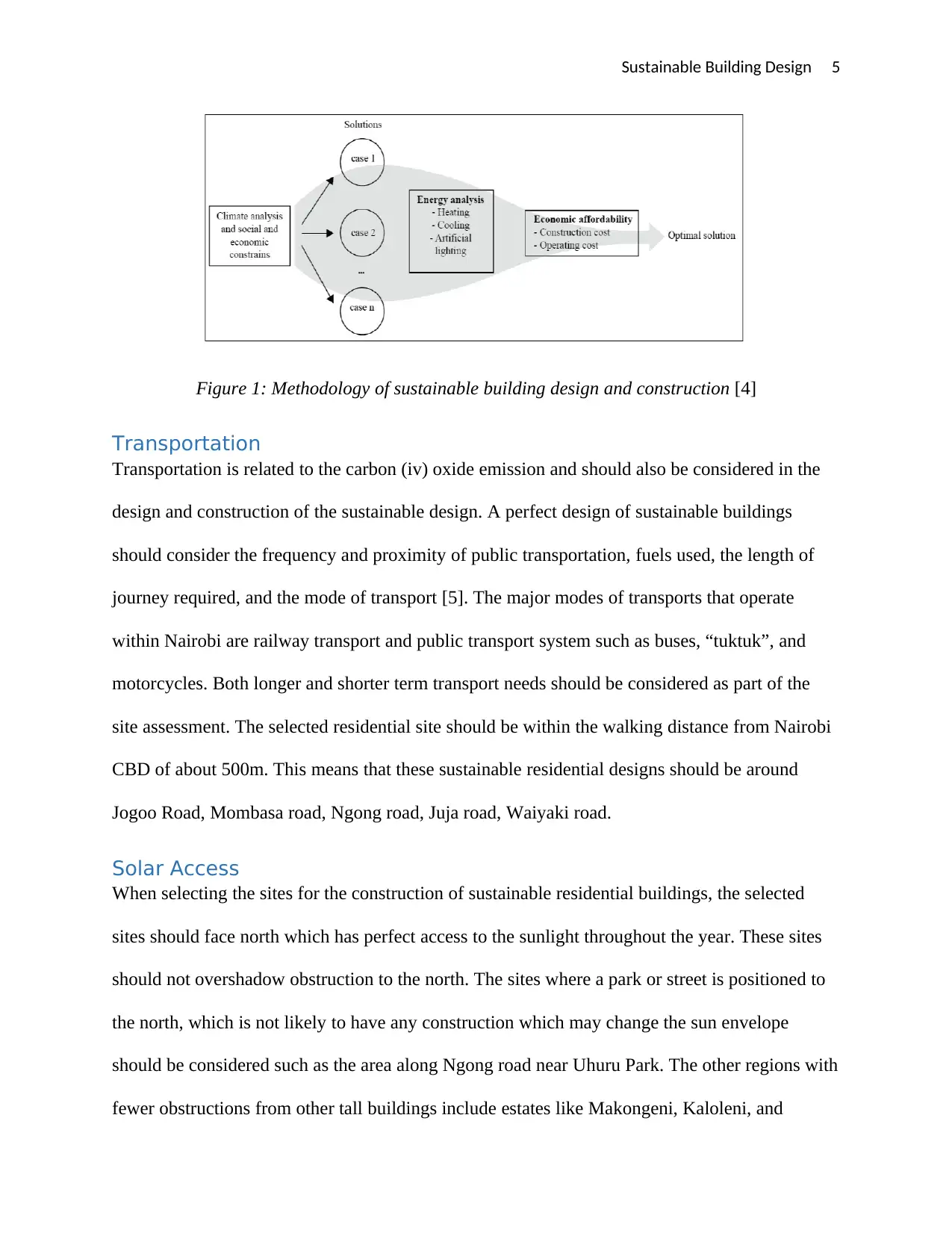
Sustainable Building Design 5
Figure 1: Methodology of sustainable building design and construction [4]
Transportation
Transportation is related to the carbon (iv) oxide emission and should also be considered in the
design and construction of the sustainable design. A perfect design of sustainable buildings
should consider the frequency and proximity of public transportation, fuels used, the length of
journey required, and the mode of transport [5]. The major modes of transports that operate
within Nairobi are railway transport and public transport system such as buses, “tuktuk”, and
motorcycles. Both longer and shorter term transport needs should be considered as part of the
site assessment. The selected residential site should be within the walking distance from Nairobi
CBD of about 500m. This means that these sustainable residential designs should be around
Jogoo Road, Mombasa road, Ngong road, Juja road, Waiyaki road.
Solar Access
When selecting the sites for the construction of sustainable residential buildings, the selected
sites should face north which has perfect access to the sunlight throughout the year. These sites
should not overshadow obstruction to the north. The sites where a park or street is positioned to
the north, which is not likely to have any construction which may change the sun envelope
should be considered such as the area along Ngong road near Uhuru Park. The other regions with
fewer obstructions from other tall buildings include estates like Makongeni, Kaloleni, and
Figure 1: Methodology of sustainable building design and construction [4]
Transportation
Transportation is related to the carbon (iv) oxide emission and should also be considered in the
design and construction of the sustainable design. A perfect design of sustainable buildings
should consider the frequency and proximity of public transportation, fuels used, the length of
journey required, and the mode of transport [5]. The major modes of transports that operate
within Nairobi are railway transport and public transport system such as buses, “tuktuk”, and
motorcycles. Both longer and shorter term transport needs should be considered as part of the
site assessment. The selected residential site should be within the walking distance from Nairobi
CBD of about 500m. This means that these sustainable residential designs should be around
Jogoo Road, Mombasa road, Ngong road, Juja road, Waiyaki road.
Solar Access
When selecting the sites for the construction of sustainable residential buildings, the selected
sites should face north which has perfect access to the sunlight throughout the year. These sites
should not overshadow obstruction to the north. The sites where a park or street is positioned to
the north, which is not likely to have any construction which may change the sun envelope
should be considered such as the area along Ngong road near Uhuru Park. The other regions with
fewer obstructions from other tall buildings include estates like Makongeni, Kaloleni, and
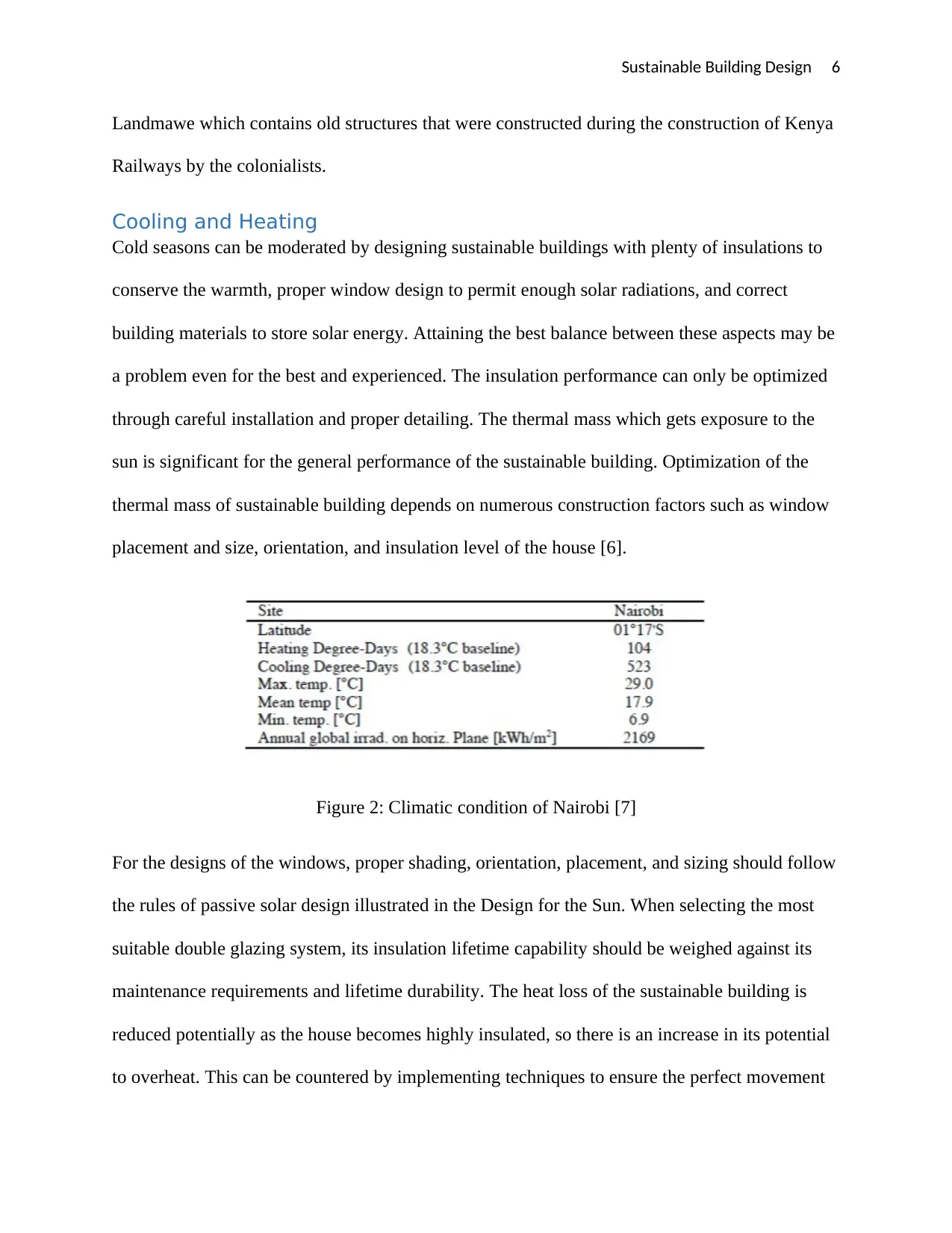
Sustainable Building Design 6
Landmawe which contains old structures that were constructed during the construction of Kenya
Railways by the colonialists.
Cooling and Heating
Cold seasons can be moderated by designing sustainable buildings with plenty of insulations to
conserve the warmth, proper window design to permit enough solar radiations, and correct
building materials to store solar energy. Attaining the best balance between these aspects may be
a problem even for the best and experienced. The insulation performance can only be optimized
through careful installation and proper detailing. The thermal mass which gets exposure to the
sun is significant for the general performance of the sustainable building. Optimization of the
thermal mass of sustainable building depends on numerous construction factors such as window
placement and size, orientation, and insulation level of the house [6].
Figure 2: Climatic condition of Nairobi [7]
For the designs of the windows, proper shading, orientation, placement, and sizing should follow
the rules of passive solar design illustrated in the Design for the Sun. When selecting the most
suitable double glazing system, its insulation lifetime capability should be weighed against its
maintenance requirements and lifetime durability. The heat loss of the sustainable building is
reduced potentially as the house becomes highly insulated, so there is an increase in its potential
to overheat. This can be countered by implementing techniques to ensure the perfect movement
Landmawe which contains old structures that were constructed during the construction of Kenya
Railways by the colonialists.
Cooling and Heating
Cold seasons can be moderated by designing sustainable buildings with plenty of insulations to
conserve the warmth, proper window design to permit enough solar radiations, and correct
building materials to store solar energy. Attaining the best balance between these aspects may be
a problem even for the best and experienced. The insulation performance can only be optimized
through careful installation and proper detailing. The thermal mass which gets exposure to the
sun is significant for the general performance of the sustainable building. Optimization of the
thermal mass of sustainable building depends on numerous construction factors such as window
placement and size, orientation, and insulation level of the house [6].
Figure 2: Climatic condition of Nairobi [7]
For the designs of the windows, proper shading, orientation, placement, and sizing should follow
the rules of passive solar design illustrated in the Design for the Sun. When selecting the most
suitable double glazing system, its insulation lifetime capability should be weighed against its
maintenance requirements and lifetime durability. The heat loss of the sustainable building is
reduced potentially as the house becomes highly insulated, so there is an increase in its potential
to overheat. This can be countered by implementing techniques to ensure the perfect movement
⊘ This is a preview!⊘
Do you want full access?
Subscribe today to unlock all pages.

Trusted by 1+ million students worldwide
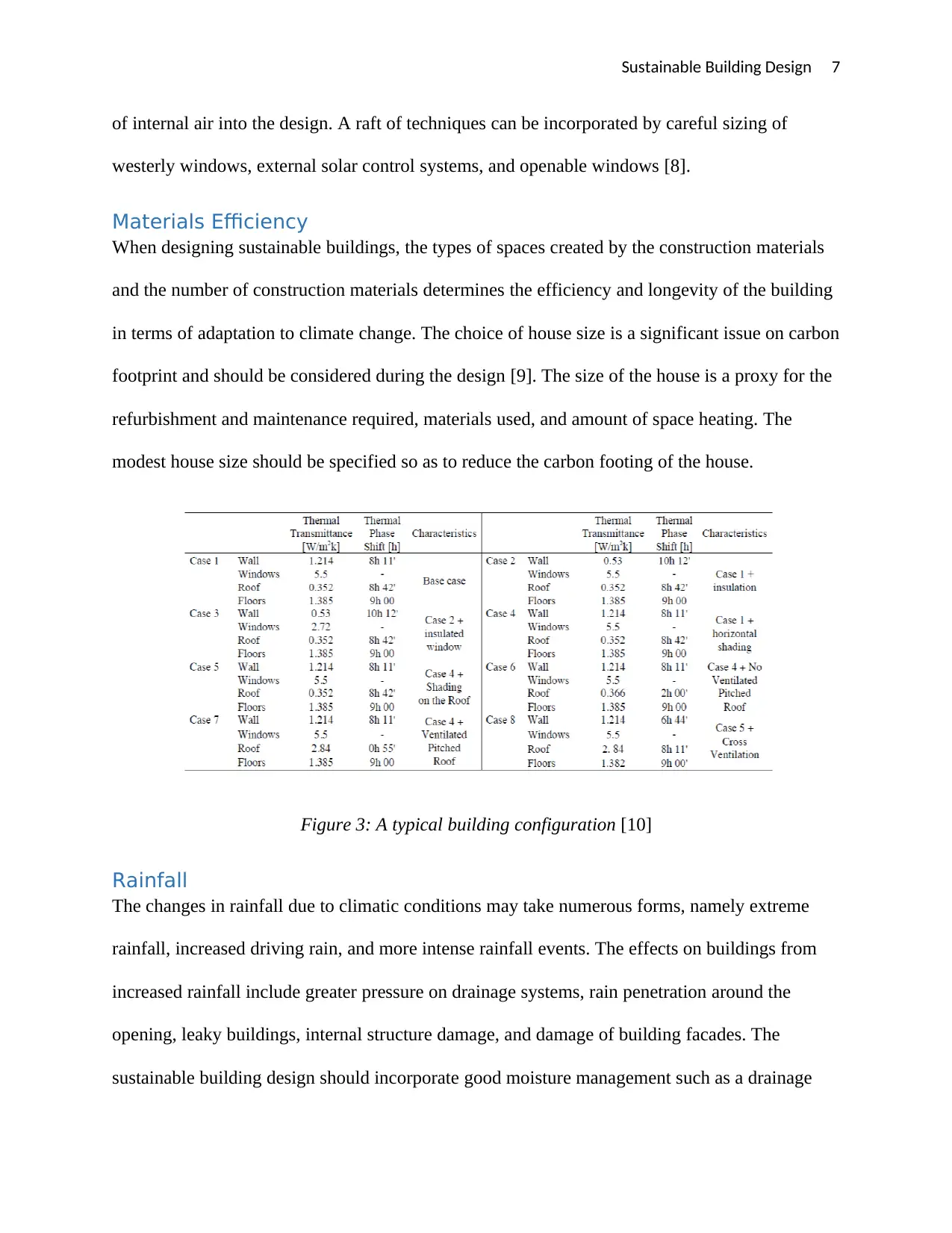
Sustainable Building Design 7
of internal air into the design. A raft of techniques can be incorporated by careful sizing of
westerly windows, external solar control systems, and openable windows [8].
Materials Efficiency
When designing sustainable buildings, the types of spaces created by the construction materials
and the number of construction materials determines the efficiency and longevity of the building
in terms of adaptation to climate change. The choice of house size is a significant issue on carbon
footprint and should be considered during the design [9]. The size of the house is a proxy for the
refurbishment and maintenance required, materials used, and amount of space heating. The
modest house size should be specified so as to reduce the carbon footing of the house.
Figure 3: A typical building configuration [10]
Rainfall
The changes in rainfall due to climatic conditions may take numerous forms, namely extreme
rainfall, increased driving rain, and more intense rainfall events. The effects on buildings from
increased rainfall include greater pressure on drainage systems, rain penetration around the
opening, leaky buildings, internal structure damage, and damage of building facades. The
sustainable building design should incorporate good moisture management such as a drainage
of internal air into the design. A raft of techniques can be incorporated by careful sizing of
westerly windows, external solar control systems, and openable windows [8].
Materials Efficiency
When designing sustainable buildings, the types of spaces created by the construction materials
and the number of construction materials determines the efficiency and longevity of the building
in terms of adaptation to climate change. The choice of house size is a significant issue on carbon
footprint and should be considered during the design [9]. The size of the house is a proxy for the
refurbishment and maintenance required, materials used, and amount of space heating. The
modest house size should be specified so as to reduce the carbon footing of the house.
Figure 3: A typical building configuration [10]
Rainfall
The changes in rainfall due to climatic conditions may take numerous forms, namely extreme
rainfall, increased driving rain, and more intense rainfall events. The effects on buildings from
increased rainfall include greater pressure on drainage systems, rain penetration around the
opening, leaky buildings, internal structure damage, and damage of building facades. The
sustainable building design should incorporate good moisture management such as a drainage
Paraphrase This Document
Need a fresh take? Get an instant paraphrase of this document with our AI Paraphraser
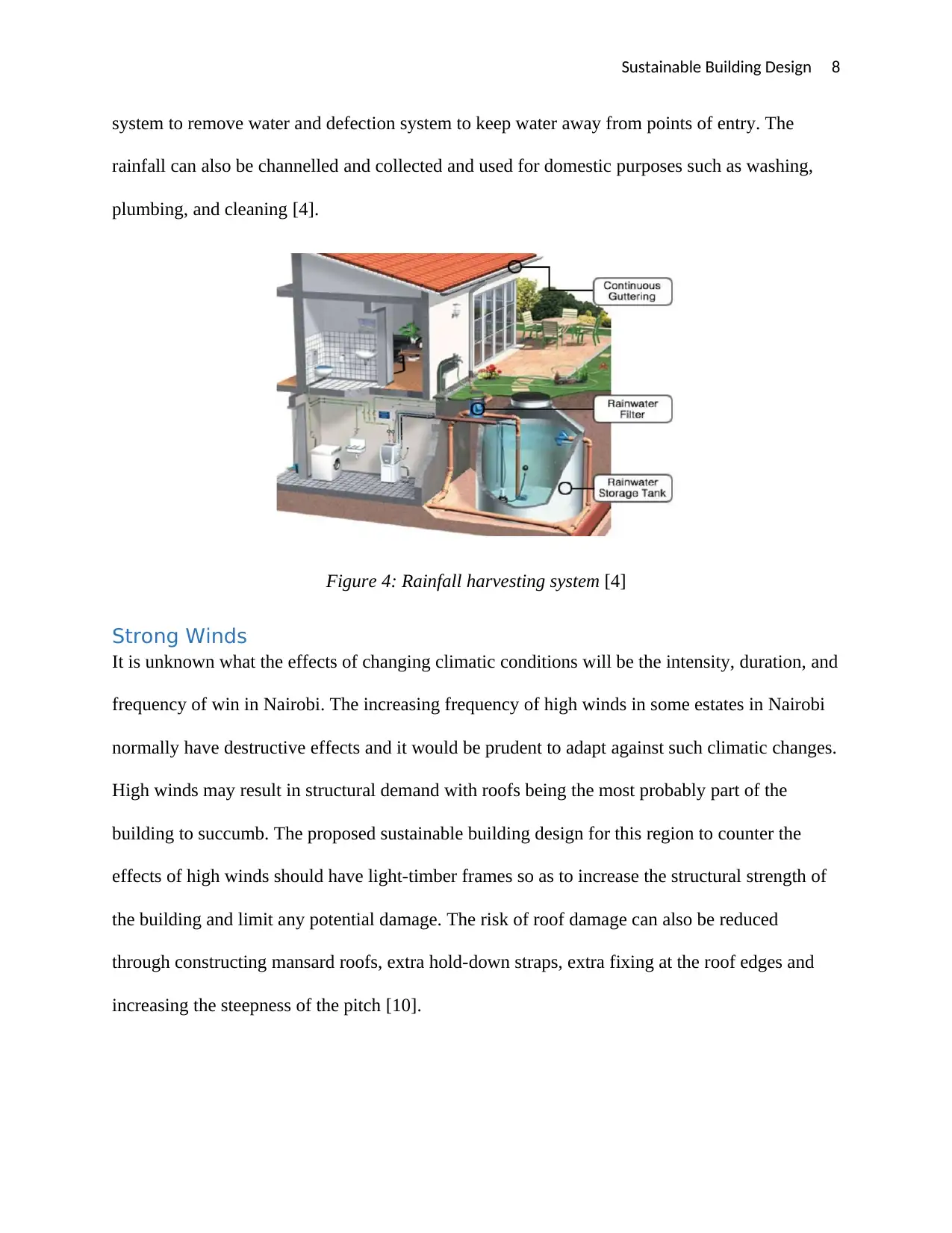
Sustainable Building Design 8
system to remove water and defection system to keep water away from points of entry. The
rainfall can also be channelled and collected and used for domestic purposes such as washing,
plumbing, and cleaning [4].
Figure 4: Rainfall harvesting system [4]
Strong Winds
It is unknown what the effects of changing climatic conditions will be the intensity, duration, and
frequency of win in Nairobi. The increasing frequency of high winds in some estates in Nairobi
normally have destructive effects and it would be prudent to adapt against such climatic changes.
High winds may result in structural demand with roofs being the most probably part of the
building to succumb. The proposed sustainable building design for this region to counter the
effects of high winds should have light-timber frames so as to increase the structural strength of
the building and limit any potential damage. The risk of roof damage can also be reduced
through constructing mansard roofs, extra hold-down straps, extra fixing at the roof edges and
increasing the steepness of the pitch [10].
system to remove water and defection system to keep water away from points of entry. The
rainfall can also be channelled and collected and used for domestic purposes such as washing,
plumbing, and cleaning [4].
Figure 4: Rainfall harvesting system [4]
Strong Winds
It is unknown what the effects of changing climatic conditions will be the intensity, duration, and
frequency of win in Nairobi. The increasing frequency of high winds in some estates in Nairobi
normally have destructive effects and it would be prudent to adapt against such climatic changes.
High winds may result in structural demand with roofs being the most probably part of the
building to succumb. The proposed sustainable building design for this region to counter the
effects of high winds should have light-timber frames so as to increase the structural strength of
the building and limit any potential damage. The risk of roof damage can also be reduced
through constructing mansard roofs, extra hold-down straps, extra fixing at the roof edges and
increasing the steepness of the pitch [10].
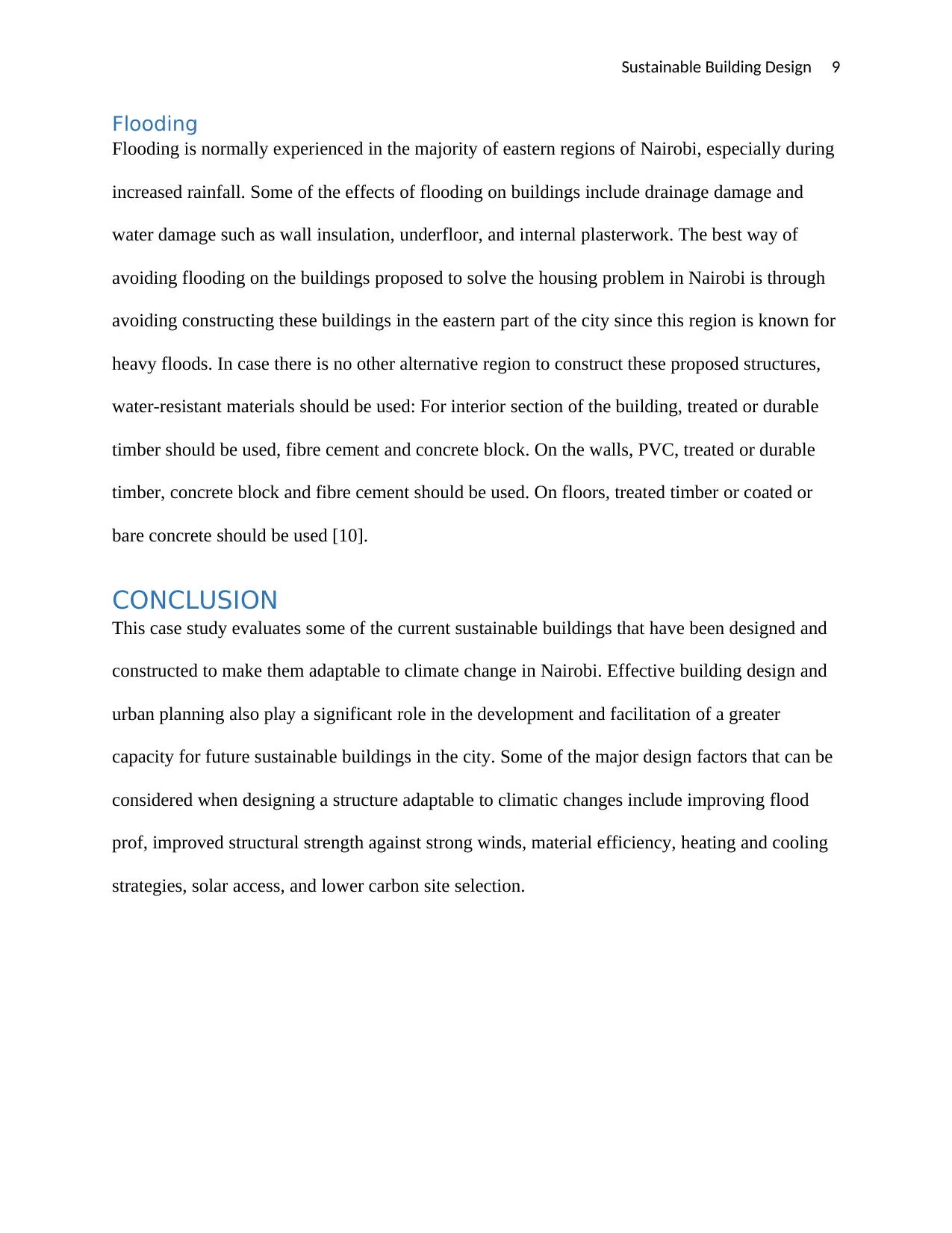
Sustainable Building Design 9
Flooding
Flooding is normally experienced in the majority of eastern regions of Nairobi, especially during
increased rainfall. Some of the effects of flooding on buildings include drainage damage and
water damage such as wall insulation, underfloor, and internal plasterwork. The best way of
avoiding flooding on the buildings proposed to solve the housing problem in Nairobi is through
avoiding constructing these buildings in the eastern part of the city since this region is known for
heavy floods. In case there is no other alternative region to construct these proposed structures,
water-resistant materials should be used: For interior section of the building, treated or durable
timber should be used, fibre cement and concrete block. On the walls, PVC, treated or durable
timber, concrete block and fibre cement should be used. On floors, treated timber or coated or
bare concrete should be used [10].
CONCLUSION
This case study evaluates some of the current sustainable buildings that have been designed and
constructed to make them adaptable to climate change in Nairobi. Effective building design and
urban planning also play a significant role in the development and facilitation of a greater
capacity for future sustainable buildings in the city. Some of the major design factors that can be
considered when designing a structure adaptable to climatic changes include improving flood
prof, improved structural strength against strong winds, material efficiency, heating and cooling
strategies, solar access, and lower carbon site selection.
Flooding
Flooding is normally experienced in the majority of eastern regions of Nairobi, especially during
increased rainfall. Some of the effects of flooding on buildings include drainage damage and
water damage such as wall insulation, underfloor, and internal plasterwork. The best way of
avoiding flooding on the buildings proposed to solve the housing problem in Nairobi is through
avoiding constructing these buildings in the eastern part of the city since this region is known for
heavy floods. In case there is no other alternative region to construct these proposed structures,
water-resistant materials should be used: For interior section of the building, treated or durable
timber should be used, fibre cement and concrete block. On the walls, PVC, treated or durable
timber, concrete block and fibre cement should be used. On floors, treated timber or coated or
bare concrete should be used [10].
CONCLUSION
This case study evaluates some of the current sustainable buildings that have been designed and
constructed to make them adaptable to climate change in Nairobi. Effective building design and
urban planning also play a significant role in the development and facilitation of a greater
capacity for future sustainable buildings in the city. Some of the major design factors that can be
considered when designing a structure adaptable to climatic changes include improving flood
prof, improved structural strength against strong winds, material efficiency, heating and cooling
strategies, solar access, and lower carbon site selection.
⊘ This is a preview!⊘
Do you want full access?
Subscribe today to unlock all pages.

Trusted by 1+ million students worldwide
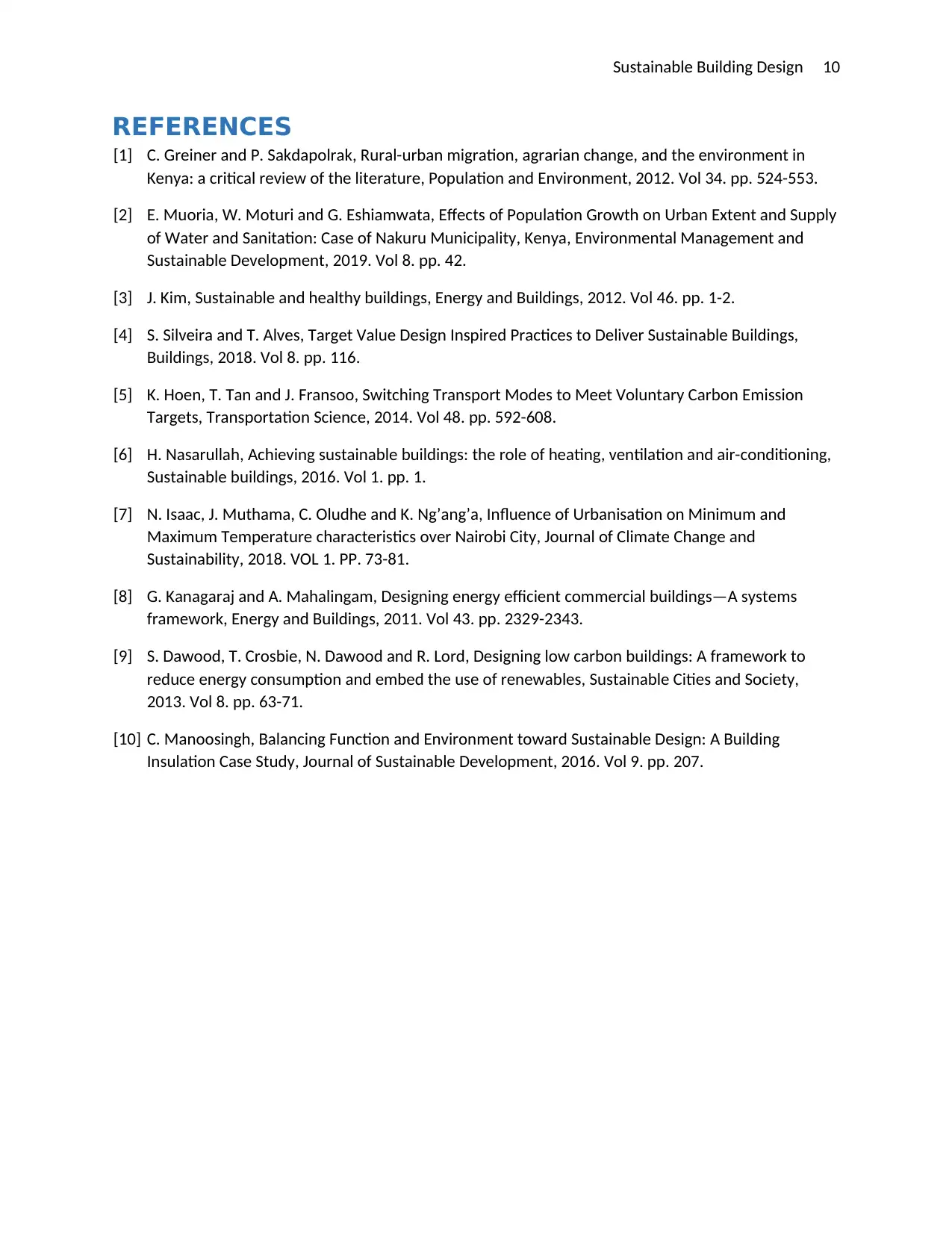
Sustainable Building Design 10
REFERENCES
[1] C. Greiner and P. Sakdapolrak, Rural-urban migration, agrarian change, and the environment in
Kenya: a critical review of the literature, Population and Environment, 2012. Vol 34. pp. 524-553.
[2] E. Muoria, W. Moturi and G. Eshiamwata, Effects of Population Growth on Urban Extent and Supply
of Water and Sanitation: Case of Nakuru Municipality, Kenya, Environmental Management and
Sustainable Development, 2019. Vol 8. pp. 42.
[3] J. Kim, Sustainable and healthy buildings, Energy and Buildings, 2012. Vol 46. pp. 1-2.
[4] S. Silveira and T. Alves, Target Value Design Inspired Practices to Deliver Sustainable Buildings,
Buildings, 2018. Vol 8. pp. 116.
[5] K. Hoen, T. Tan and J. Fransoo, Switching Transport Modes to Meet Voluntary Carbon Emission
Targets, Transportation Science, 2014. Vol 48. pp. 592-608.
[6] H. Nasarullah, Achieving sustainable buildings: the role of heating, ventilation and air-conditioning,
Sustainable buildings, 2016. Vol 1. pp. 1.
[7] N. Isaac, J. Muthama, C. Oludhe and K. Ng’ang’a, Influence of Urbanisation on Minimum and
Maximum Temperature characteristics over Nairobi City, Journal of Climate Change and
Sustainability, 2018. VOL 1. PP. 73-81.
[8] G. Kanagaraj and A. Mahalingam, Designing energy efficient commercial buildings—A systems
framework, Energy and Buildings, 2011. Vol 43. pp. 2329-2343.
[9] S. Dawood, T. Crosbie, N. Dawood and R. Lord, Designing low carbon buildings: A framework to
reduce energy consumption and embed the use of renewables, Sustainable Cities and Society,
2013. Vol 8. pp. 63-71.
[10] C. Manoosingh, Balancing Function and Environment toward Sustainable Design: A Building
Insulation Case Study, Journal of Sustainable Development, 2016. Vol 9. pp. 207.
REFERENCES
[1] C. Greiner and P. Sakdapolrak, Rural-urban migration, agrarian change, and the environment in
Kenya: a critical review of the literature, Population and Environment, 2012. Vol 34. pp. 524-553.
[2] E. Muoria, W. Moturi and G. Eshiamwata, Effects of Population Growth on Urban Extent and Supply
of Water and Sanitation: Case of Nakuru Municipality, Kenya, Environmental Management and
Sustainable Development, 2019. Vol 8. pp. 42.
[3] J. Kim, Sustainable and healthy buildings, Energy and Buildings, 2012. Vol 46. pp. 1-2.
[4] S. Silveira and T. Alves, Target Value Design Inspired Practices to Deliver Sustainable Buildings,
Buildings, 2018. Vol 8. pp. 116.
[5] K. Hoen, T. Tan and J. Fransoo, Switching Transport Modes to Meet Voluntary Carbon Emission
Targets, Transportation Science, 2014. Vol 48. pp. 592-608.
[6] H. Nasarullah, Achieving sustainable buildings: the role of heating, ventilation and air-conditioning,
Sustainable buildings, 2016. Vol 1. pp. 1.
[7] N. Isaac, J. Muthama, C. Oludhe and K. Ng’ang’a, Influence of Urbanisation on Minimum and
Maximum Temperature characteristics over Nairobi City, Journal of Climate Change and
Sustainability, 2018. VOL 1. PP. 73-81.
[8] G. Kanagaraj and A. Mahalingam, Designing energy efficient commercial buildings—A systems
framework, Energy and Buildings, 2011. Vol 43. pp. 2329-2343.
[9] S. Dawood, T. Crosbie, N. Dawood and R. Lord, Designing low carbon buildings: A framework to
reduce energy consumption and embed the use of renewables, Sustainable Cities and Society,
2013. Vol 8. pp. 63-71.
[10] C. Manoosingh, Balancing Function and Environment toward Sustainable Design: A Building
Insulation Case Study, Journal of Sustainable Development, 2016. Vol 9. pp. 207.
1 out of 10
Related Documents
Your All-in-One AI-Powered Toolkit for Academic Success.
+13062052269
info@desklib.com
Available 24*7 on WhatsApp / Email
![[object Object]](/_next/static/media/star-bottom.7253800d.svg)
Unlock your academic potential
Copyright © 2020–2025 A2Z Services. All Rights Reserved. Developed and managed by ZUCOL.




